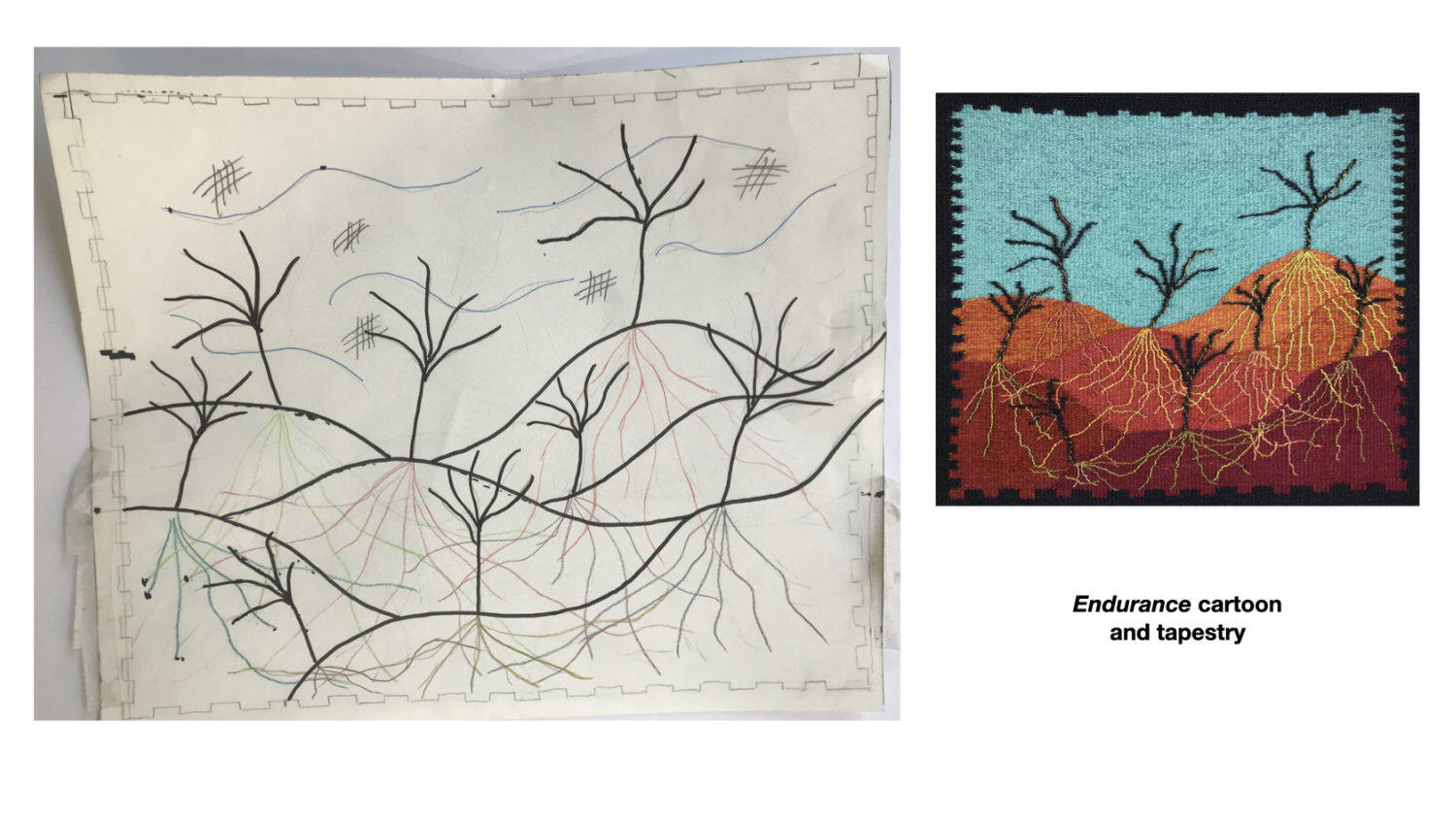Annotating a Tapestry Cartoon
My current cartoon board
A cartoon in tapestry is a full-sized sketch that serves as a guide for the weaver. It can range from simple outlines to very detailed drawings- or paintings even- complete with annotations on techniques, colors, yarns, or other pertinent information. Much as the entire design process is, cartoons and how they are done (or not done) are tailored to personal preference.
I had a question recently in one of my classes on annotating cartoons, so I thought I’d post my process here.
I’ll just say I have not annotated my cartoons in the past. I have always had a very simplified outline approach. I create a minimal outlined cartoon and allow for the tapestry and sometimes even the idea to evolve during the weaving process.
For my most recent pieces, I’ve had a lot of lines crossing one way or another, usually done with vertical Soumak, and I have found myself building in a sort of coding to my cartoons. I’ve done this with color, though, not notes. The colors keep me (and my lines) in line.
The question that was asked was more in keeping with some sort of code, like symbols in knitting charts.
We’re doing a lot of different techniques in the Soumak course and it can be challenging to keep them straight during the weaving process. Especially when more than one or two of the methods are being used.
Here are my two most recent pieces where I felt the need to “code” my cartoon. I chose to do it with colored lines - in keeping with what I’d been doing before.
Roots
In this piece, I used different colors to depict different colors of lines. For both these earlier pieces, I did make some notes in my journal as to what color went with what yarn combination. This has been my method rather than putting it onto the cartoon.
Endurance
This time I had one color assigned to each Soumak weft - or I could say one color assigned to each specific tree, making it easier to stay on track.
My newest piece is a different sort. This time I am using many different Soumak techniques to create the tree trunk. And I feel the need of a system to keep them straight. Something in addition to those notes in my journal.
Inspiration for the tree trunk
This sample was done completely free-form with no cartoon. I kept track with scribbled notes in my journal - after the fact. More a way to record what I did rather than tell me what to do next. But I later realized how jumbled and chaotic those notes were. The question about annotating suddenly made perfect sense!
So here’s the evolution of this newest piece to date
I drew the design out on graph paper to size based on my original sketch, which was much smaller. The sections of the bark were intended to have different Soumak techniques- and different color bundles.
I came up with a code for the different techniques. I teach the course with a system that describes the wrap made, so it made sense to do something like this:
C- closed
O- open
-C clockwise
-CC counterclockwise
So, for instance, C-CC would be closed, counterclockwise.
Because I was doing Double Soumak techniques, I had to also show the two steps. It could be read top to bottom or bottom to top. I preferred bottom to top because it most closely resembled the directions of the wraps.
First I added the code to the bark of the tree.
Next I needed to work on the mycellium lines. These were to be one color, so could get a little dicey as the weaving progressed. I decided to run one strand of cotton sewing thread along with the main color to maintain the lines crossing each other.
The new design thus far…
This is as far as I have taken it. I could also denote the color bundle used - OR (my preference) use the same technique for each color bundle, as you see here in this cartoon.
During this process, a lot has changed already. I went from a bundle of 3 to 2 weft yarns for the Double Soumak techniques. I’m going for the textures, but not necessarily a lot of relief.
I also have decided I want to keep the essence of that small sample, so will be doing the Double Soumak techniques more in keeping with that style, which will most likely be organic and free-form.
Do you annotate your cartoons for tapestry?
Make notes as to what techniques to use - some kind of code to keep you straight as you weave?





